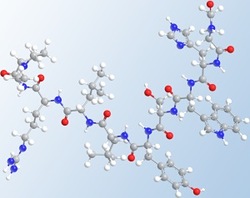A potential drug treatment for a form of motor neuron disease passes its first large-scale clinical trial

The drug candidate leuprorelin (pictured) has been shown to be safe in humans and could help treat the debilitating disease known as spinal and bulbar muscular atrophy.
Spinal and bulbar muscular atrophy (SBMA) is an inherited motor neuron disease that affects up to one in 50,000 males, and is characterized by muscle wasting and weakness in the face, limbs and torso. It is caused by a mutation in the androgen receptor, an important developmental receptor that binds to the male sex hormone testosterone.
Although there is no treatment for SBMA, animal studies have shown that a drug called leuprorelin delays the onset of the muscular deficits by reducing the release of testosterone from the testes.
Now, a large-scale clinical trial led by Masahisa Katsuno from the Nagoya University GCOE for Molecular Medicine1 has provided new information on the effect and safety of long courses of leuprorelin for human patients with SBMA.
Masahisa Katsuno and his colleagues recruited a total of 204 patients with SBMA as part of the Japan SBMA Interventional Trial for TAP-144-SR -- a randomized, placebo-controlled double-blind trial involving 14 hospitals throughout Japan.
Patients were randomly assigned to either the experimental or control group. Those in the experimental group were given subcutaneous injections of leuprorelin every 12 weeks for 48 weeks, while the controls received an identical dosage of a placebo.
The researchers found that the 48-week leuprorelin treatment regimen was well tolerated by the patients, revealing no significant differences in the number of drug-related adverse effects between the experimental and control groups.
SBMA patients often experience difficulties with swallowing due to degeneration of motor neurons in the brain stem, or bulbar region, and the researchers used this symptom to measure the efficacy of leuprorelin treatment. The patients' swallowing function was assessed by asking all patients to swallow a small volume of a barium sulphate solution and then monitoring the swallowing action using a technique called video fluorography.
Although the researchers found no statistically significant difference in swallowing function between the experimental and control groups, they observed that leuprorelin could be effective in patients that have had the disease for less than ten years.
"The videofluorography method we used may not have been able to fully characterize the subtleties in swallowing function between placebo- and leuprorelin-treated patients," says Katsuno. This could be due to pronounced variability in the way in which the barium sulphate was consumed by the patients.
"We are now planning another clinical trial of leuprorelin for SBMA, using alternative measures such as the average of three videofluorography sessions to enhance the sensitivity of the technique."
Affiliated Researchers
The Nagoya University affiliated researchers mentioned in this highlight are from the Integrated Functional Molecular Medicine for Neuronal and Neoplastic Disorders GCOE program of the School of Medicine.
Reference
- Katsuno, M. et al. Efficacy and safety of leuprorelin in patients with spinal and bulbar muscular atrophy (JASMITT study): a multicentre, randomised, double-blind, placebo-controlled trial. The Lancet Neurology 9, 875-884 (2010). | article